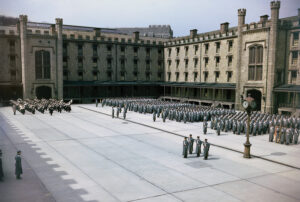Agents informed Pak Sang-hyon in Compound 62 that General Nam had named him chief resistance leader. With the help of colonels Lee and Hong, Pak was to seize control of as many of Koje-do’s compounds as possible and use violence to antagonize the Koje-do guards and administration. POW losses would be inevitable, and retribution was encouraged to ensure press coverage. The ultimate goal was a combined POW-guerrilla attack to seize the island. The resisters-especially the leaders-would be heroes welcomed back to the ranks of the Communist faithful. If they failed, their families would die-or suffer worse.
The Communist resisters and their anti-Communist counterparts tested their strength over the issue of screening the remaining Korean civilian internees, most of them former South Korean soldiers and guerrilla suspects. Compound 63 produced the vanguard anti-Communist camp government, supported by an ultra-patriotic paramilitary society called the Hwarang Association. When South Korean screening teams approached Communist-dominated Compound 62, 300 members of the Hwarangs arranged a transfer to Compound 62 to assist the screening by doing away with the Communist organizers.
The compound had already been the scene of a reign of terror against the non-Communists, a minority of the 5,000 captives. Deaths and torture had been inflicted by beating, burning, electrocution, castration, mutilation, and drowning.
The coup attempt went awry and produced a riot. After three hours of violence on December 18, 1951, that left 14 dead and 24 wounded, the South Korean guards rescued the Hwarangs and 100 other anti-Communists. Three days later, all civilian internee screening ended in Compound 62, now under complete Communist control. Pak Sang-hyon became the first commissar of the resistance leadership.
The camp commander, Col. Maurice J. Fitzgerald, continued to feed the captives but attempted no other contact with Compound 62. Instead, Fitzgerald surrounded the compound with guard strongpoints designed to prevent a breakout. Pak and his cadre displayed protest signs in Korean and English, drilled with spears, sang and chanted with revolutionary fervor, and threw rocks at passersby. The civilian internee screening and the indoctrination program began to falter in other Korean compounds.
The resumption of armistice negotiations on November 27, 1951, brought a dramatic escalation of POW resistance. The issue was the final disposition of the POWs. The Communists, citing the Geneva Convention of 1949, argued that each side had to return all captives and internees without any consideration of the POWs’ personal preferences. The Communists feared a potential propaganda disaster-multitudes of Korean and Chinese voluntarily and loudly rejecting Communism.
The UN Command saw the issue differently. General Ridgway suspected that he held far more POWs than the Communists, even if as many as 41,000 Koreans were reclassified from POW to civilian internee status and held out of the POW exchange, not being enemy combatants. The UN Command held at least 100,000 POWs, while the Communists had perhaps 6,000 American and allied troops and maybe 28,000 South Korean soldiers.
The U.S. Joint Chiefs of Staff favored a one-for-one exchange, but would accept “all for all,” and as quickly as possible to save lives. Ridgway had ample evidence that Communists were committing atrocities against prisoners in North Korea, and allied POWs certainly lived in miserable conditions. Yet “all for all” also meant returning war criminals, collaborators, intelligence operatives, and many innocents to Communist control.
The POW exchange issue escalated when South Korea’s Syngman Rhee demanded no forced repatriation, the immediate release of cleared civilian internees, and the prosecution of war criminals. The Truman administration divided; only the president himself could resolve the issue.
In December 1951, Truman chose voluntary repatriation. With the president’s approval, the actual plan envisioned a two-phase exchange: “one for one” until all UN Command POWs had been released, and then voluntary repatriation. The Chinese negotiators originally considered the proposal a stalling tactic related to other issues like the location of the future military demarcation line. The North Koreans accused the UN Command of covering up its own war crimes and of POW intimidation. Nevertheless, all sides agreed to prepare a list of POWs in custody.
The exchange of these hurriedly compiled lists surprised, shocked, and outraged each side. The South Korean army estimated it had lost 70,000 soldiers to captivity and could not account for 88,000 others. Yet, the Communists claimed to hold only 7,412 South Korean soldiers. (In fact, the Communists had impressed thousands into their own armed forces, where many died in action. Thousands of others, mainly “class enemies,” died in slave labor camps from which POWs were still escaping four decades later.)
The lists had surprises. The UN Command had more than 10,000 MIAs and thought at least 6,000 were-or had been-in enemy hands. Nevertheless, only 3,198 American names were listed, 1,219 from other allied units, and the list excluded some people known to be POWs.
The Communists were equally shocked (or put on a convincing act) to learn that the UN Command held only 95,531 Communist Koreans, 16,243 uncleared South Koreans, and 20,700 Chinese soldiers. They also heard estimates from Western sources that more than half their POWs would refuse repatriation.
As the Communist POW resistance organized in early 1952, the conditions for exchanging prisoners came to dominate the Panmunjo?m negotiations. The UN Command position, formed in Washington, was that no POW would be repatriated against his will. The Communists insisted that the Geneva Convention of 1949 required that all POWs be returned. The Communist POW resisters, now with plenty of incentive, tested the camp administrators in a violent protest on February 18, 1952. Armed with rocks, clubs, and spears, between 1,000 and 1,500 inmates of Compound 62 attacked a South Korean team trying to rescue non-Communist civilian internees in the compound. A battalion of the U.S. 27th Infantry fought back, killing 75 captives and wounding 139 others. One GI died in the melee and 22 were wounded. Five days later General Nam charged the UN Command with “barbarously massacring” large numbers of harmless civilian internees.
With neither side wavering on POW exchange at Panmunjo?m, Ridgway planned to screen all the Koje-do captives for their preference on repatriation, at Washington’s direction. He ordered “a detailed plan to provide for the selection, segregation and protection of those North Korean and Chinese Communist prisoners of war who would violently oppose repatriation to Communist control.” The South Korean POWs or civilian internees would be allowed to elect repatriation or to stay in South Korea. Ridgway warned Van Fleet to ensure that disorder, riot, and bloodshed were kept to an absolute minimum. He advised taking as little time as possible for the screening, “preferably during daylight hours of a single day.”
[continued on next page]




